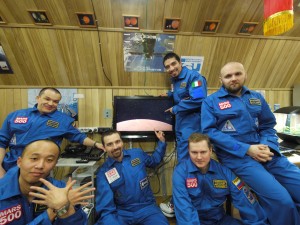In the year 2023, and humans are on Mars for all to see

Do you wish to become a Martizen, a citizen of Mars, anytime in the near future? If you are serious about this then Dutchman, Bas Lansdorp is your man.
Bas Lansdorp is a person with an audacious ambition. Through his company, Mars One, he plans to establish the first human settlement on Mars by April 2023. In addition to this he intends that a new team of four settlers will join the Martian settlement every two years. By 2033 there will be over twenty people living, working, and they believe, flourishing on Mars, their new home.
If the Mars one publicity is believable, and on this point there is no real reason to doubt it, organizing a manned mission to Mars has been Bas Lansdorp’s dream for many years. Bas has been working on Mars One with partner Arno Wielders since January 2011. During 2011 they had confidential discussions with possible equipment suppliers to ensure that there was reality in their idea. In May 2012 they announced their vision to the world.
Like any large entrepreneurial venture their success will predicated on the skill, experience and credibility of the venture and the people involved. To be credible they will need to be convincing in, at least, these four aspects of the venture; technological; financial; psychological; and finally ethical. They will need to be convincing in a way that engages and excites both investors and participants.
Getting to Mars is not trivial, if it were, well I expect there would be more than the spectacular array of NASA super, and superannuated rovers there currently is on Mars. Mars One have developed and made integral to their model a simple theme to get to and live on Mars: buy already developed technology from existing component manufacturers.
Take the Falcon Heavy lifter from SpaceX, to boost the components into low earth orbit. Combine a SpaceX Dragon capsule as the landing stage, add a transit living module from Thales Alenia Space and attach to two propellant stages which are a variant of the SpaceX Falcon 9 upper stage rockets and you have the vehicle to get from low earth orbit to orbit around Mars via a Hohmann transfer trajectory.
The seven-month trip to mars will be Spartan, similar to, but more cramped, than current conditions experienced on the International Space Station. This is where rigorous training will first pay off:
“Showering won’t be an option; instead they will have to make do with wet wipes like the International Space Station astronauts. Tinned food only, constant noise from the ventilators and equipment and a regimented routine of three hours of exercise a day to keep up muscle mass all add to their trials. If they are hit by a solar storm they will have to take refuge in the shelter area of the rocket, which provides the best protection, for as long as several days.”
When the first 4 settlers land on Mars in April 2023 they will arrive at an established site. They will be picked up from their SpaceX Dragon capsule and taxied to the settlement by two robotic Mars rovers designed and built by MDA Space Missions. To get to this point is an ambitious and tight timeline.
| 2013 | Settler selection begins. Replica of Mars settlement is built on an Earth desert to help the settlers prepare and train, and for a realistic environment in which to test the equipment. The settler selection and the preparations in the simulated Mars base will be broadcast on television and online for the public to view. |
| 2014 | Preparation for the supplies mission. Production of the first Mars communication satellites. |
| 2016 | January launch of the supplies mission, landing in October, includes the first habitat module (modified Dragon capsule) and 2500kg of supplies. |
| 2018 | First robotic rover lands (again in a modified Dragon capsule) to enable the pick of the specific settlement site. |
| 2021 | A total of 2 robot rovers, 2 living units, 2 life support units and 2 supply units are now all present at the Mars settlement site. |
| 2022 | All H2O, O2, and atmosphere production will be ready before a go-ahead to launch the settlers. |
| 2023 | First 4 settlers arrive at the Mars settlement. |
| 2025 | Second group of 4 settlers arrive, to be no doubt enthusiastically greeted by the pioneering first four. |
Once arrived there will be work for the settlers to connect up the various habitats. However once complete they will have substantial living space, 50m²+ each, equipped with showers, flushing toilets and kitchens. The living units are a Dragon capsule with an inflatable living section supplied by ILC Dover, who have supplied NASA with space suits and landing bags for the previous Mars rovers Opportunity and Spirit. The inflatable living sections are to be covered in Martian regolith to provide adequate radiation shielding.

When moving around on the Mars surface the settlers will be wearing Mars suits, similar to the suits worn by the Apollo astronauts on the Moon. These suits will be made by Paragon Space Developments, the same company who provide NASA with ‘extra-vehicular’ suits, for when astronauts work in space outside the International Space Station.
By focussing on proven existing technologies Mars One are certainly presenting a reliable low cost technology solution. It is also deceptively simple. Let us remind ourselves this is a first, these conditions will be new.
For example the first step to settlement, safely landing the settlers on Mars, is unproven at present. NASA has described the process of entering the Red Planet’s atmosphere and slowing down to land as “six minutes of terror.” Computer graphics of Mars landings, in full colour and exquisite detail do not provide the simple fact that landing payloads that are large enough to bring humans and sustain their survival on the Red Planet is still beyond our capability. Currently NASA expects to have testable solutions to this some time in 2014.
Similarly we could look at the Mars suits and pose, repairs? replacements? These will be an absolute necessity for survival, however you won’t be able to buy a replacement online or wander down to high street shops to get an upgraded model or new one for a growing Martizen child.
Competent and knowledgeable engineers and specialists, as well as countless armchair experts, will no doubt be picking apart the technology of the Mars One mission, as I have just briefly done. There is no doubt that each step of the timetable above has a myriad of ‘first-time’ problems that will require solutions, some of which can be inferred some which will only become apparent as the experience proceeds. I hope that all involved have read Gregory Benson’s 1999 novel, The Martian Race, a gripping primer to life on Mars.
Show me the money

Getting to Mars is not cheap. Since the late 1940s there have been many proposals for manned exploration and settlements on mars. A commonality is that they are all pitched 10-20 years in the future and large sums of money are mentioned. To put this into today’s context on August 6 (EDT), 2012 NASA’s Mars rover, Curiosity, will land on Mars. This mission will place an 899kg six-wheeled, un-manned science laboratory on Mars; for the approximate mission cost of US$2.5B. It is expected that a 2030s NASA mission to Mars will be of the order of US$20B. Mars One says it will cost them US$6B to put the first four settlers on Mars.
In many ways focusing on the mission cost is a furphy. NASA mission budgets come from USA public purses and there is always great argument in the US Senate about the value of such publically funded scientific enterprise. In the US this argument is always balanced by the technology and enterprise that this brings to US companies and the economy. Mars One have no such public funding in mind. They intend to buy the above technologies based on price and quality, not through political or national preferences.

The ability to fund such a mission will depend on what value it returns for investors. Here is the Mars One point of difference; funding will be via sponsorship and as the World’s largest media event. If I were a settler having ILC Dover and Paragon Space Development would be more reassuring than IKEA on my Living and Life Support Modules. As for the thought of a 7 months trip to Mars eating McDonalds pre-prepared ‘meals’ that would be unpalatable. Choose the sponsors wisely Mars One.
There are no stated scientific or economic goals. Instead they see it this way:
“A manned mission to Mars is one of the most exciting, inspiring and ambitious adventures that mankind can take on. We see this as a journey that belongs to us all, and it is for this reason that we will make every step one that we take together. This will also be our way to finance the mission: the mission to Mars will be the biggest media event ever! The entire world will be able to watch and help with decisions as the teams of settlers are selected, follow their extensive training and preparation for the mission and of course observe their settling on Mars once arrived. The emigrated astronauts will share their experiences with us as they build their new home, conduct experiments, and explore Mars. The mission itself will provide us with invaluable scientific and social knowledge that will be accessible to everyone, not just an elite select few.”
To assist in making this worldwide media frenzy Mars One has enlisted Paul Römer as an ambassador. An established expert on grasping the attention of a global public, he was the co-creator of the worldwide phenomenon “Big Brother” – the television program that revolutionized reality television.
The 24/7 Martizen lab-rat
More than the tangibles of this venture, I believe it will be the intangible elements that make this a standout human endeavour. Especially the ethics and psychology of the Martizen being media fodder 24/7. A previous article has already questioned the ethics of such, admitedly voluntary, surveillance.
The psychology of such surveillance is fascinating and worrying. Even the most extroverted of people have private lives. Only the totally naive display ‘real’ faces through the public media. Media such as facebook display a mixture unconscious representations, as well as carefully and foolishly contrived facets of our lives. In many cases events are morphed and selectively recorded on media such as facebook and twitter. It is one thing to post to your facebook friends, it is quite a different thing to know that all that you do will be on display for a public you do not know.
It is hopefully obvious that the narcissist, wastrel, celebrity personalities that populated the many versions of Big Brother are not what will make a great four-person team on Mars. I also am happy to be labelled an ‘elitist’ and state that public participation via stringent selection processes, such as voting-off someone you don’t like, will be a disaster for a serious mission.
I am unsure how history’s first off-world conception, birth and death will go as media events. I can appreciate the lure for marketers of such landmark voyeuristic events, I am at the same time unsure how the participants of such private events will feel.

There is psychologically a world of difference between the isolation that would be experienced in genuine remote exploration, think Antarctica, to the pseudo-isolation of contrived event that has a definite endpoint, think Big Brother and Survivor. The Marsonauts of Mars500 ended with smiling faces after their 17 month long isolation experiment. The European Space Agency’s Directorate of Human Spaceflight has a long tradition of conducting research on the physiological and psychological aspects of spaceflight. In light of this, ESA undertook the Mars500 cooperative project with the Russian Institute for Biomedical Problems (IBMP) in Moscow, in 2010-11. This all male crew experiment is instructive, and illuminating for Mars One, however no matter how ‘isolated’ Moscow may feel, like the people in the Big Brother household, they could if they chose leave at any stage.
Despite this a key science project during Mars500 was to determine the implications of personal values held by individual crew-members for compatibility within the group as a whole or otherwise, and for individual coping strategies and adaptation during long lasting confinement. On a human exploration mission to Mars, the psychological resilience of the crew will play a critical role for the maintenance of health and performance and hence the success of the mission. One factor impacting on psychological resilience is the personal values of crew members defining their motivational goals and attitudes. Crew member selection is for real, not a game where if a poor choice is made they leave the set or you re-boot the computer.
It’s a one-way trip
That is one clear distinction this is a one-way journey. Since returning astronauts from the surface of Mars is one of the most difficult, and expensive, parts of a Mars mission, the idea of a one-way trip to Mars has been proposed several times. The notion of settlers, rather than expedition astronauts changes the technology and psychology of the mission.
A one-way trip scenario has been proposed seriously a number of times since 1998. Including a 2004 proposal by Paul Davies. Another organisation, Mars to Stay, proposed that astronauts sent to Mars for the first time should stay there indefinitely, both to reduce mission cost and to ensure permanent settlement of Mars. Among many notable Mars to Stay advocates, former Apollo astronaut Buzz Aldrin is a particularly outspoken promoter who has suggested in numerous forums “Forget the Moon, Let’s Head to Mars!”
During a 2009 public hearing of the U.S. Human Space Flight Plans Committee at which Robert Zubrin presented a summary of the arguments in book The Case for Mars, dozens of placards reading “Mars Direct Cowards Return to the Moon” were placed throughout the Carnegie Institute. The passionate uproar among space exploration advocates – both favourable and critical – is an indication of the interest in Mars exploration.
I find the Mars to Stay idea appealing and compelling for both economic and safety reasons. More emphatically, I find it a representation of the spirit of human exploration and discovery. Also personally it is a fulfilment of the ultimate mandate by which manned space programs (US, European, Russian, Chinese, Indian, Japanese etc.) are sold, at least philosophically and long-term, as a step to colonizing other worlds. I hope that Mars One either credibly fulfils this trust or propels alternative programs that deliver human settlement on Mars via a well-defined (i.e. non-suicidal) exploration program.
 Follow
Follow

3 thoughts on “In the year 2023, and humans are on Mars for all to see”
Comments are closed.